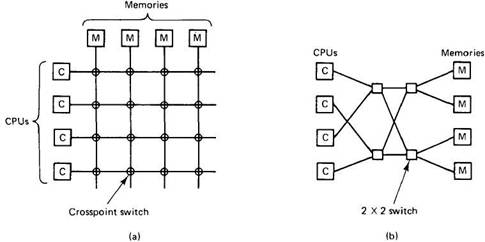Книга: Distributed operating systems
1.3.2. Switched Multiprocessors
1.3.2. Switched Multiprocessors
To build a multiprocessor with more than 64 processors, a different method is needed to connect the CPUs with the memory. One possibility is to divide the memory up into modules and connect them to the CPUs with a crossbar switch, as shown in Fig. 1-6(a). Each CPU and each memory has a connection coming out of it, as shown. At every intersection is a tiny electronic crosspoint switch that can be opened and closed in hardware. When a cpu wants to access a particular memory, the crosspoint switch connecting them is closed momentarily, to allow the access to take place. The virtue of the crossbar switch is that many CPUs can be accessing memory at the same time, although if two CPUs try to access the same memory simultaneously, one of them will have to wait.

Fig. 1-6. (a) A crossbar switch. (b) An omega switching network.
The downside of the crossbar switch is that with n CPUs and n memories, n? crosspoint switches are needed. For large n, this number can be prohibitive. As a result, people have looked for, and found, alternative switching networks that require fewer switches. The omega network of Fig. 1-6(b) is one example. This network contains four 2?2 switches, each having two inputs and two outputs. Each switch can route either input to either output. A careful look at the figure will show that with proper settings of the switches, every CPU can access every memory. These switches can be set in nanoseconds or less.
In the general case, with n CPUs and n memories, the omega network requires log2n switching stages, each containing n/2 switches, for a total of (n log2n)/2 switches. Although for large n this is much better than n?, it is still substantial.
Furthermore, there is another problem: delay. For example, for n = 1024, there are 10 switching stages from the CPU to the memory, and another 10 for the word requested to come back. Suppose that the CPU is a modern RISC chip running at 100 MIPS; that is, the instruction execution time is 10 nsec. If a memory request is to traverse a total of 20 switching stages (10 outbound and 10 back) in 10 nsec, the switching time must be 500 picosec (0.5 nsec). The complete multiprocessor will need 5120 500-picosec switches. This is not going to be cheap.
People have attempted to reduce the cost by going to hierarchical systems. Some memory is associated with each CPU. Each CPU can access its own local memory quickly, but accessing anybody else's memory is slower. This design gives rise to what is known as a NUMA (NonUniform Memory Access) machine. Although NUMA machines have better average access times than machines based on omega networks, they have the new complication that the placement of the programs and data becomes critical in order to make most access go to the local memory.
To summarize, bus-based multiprocessors, even with snoopy caches, are limited by the amount of bus capacity to about 64 CPUs at most. To go beyond that requires a switching network, such as a crossbar switch, an omega switching network, or something similar. Large crossbar switches are very expensive, and large omega networks are both expensive and slow. NUMA machines require complex algorithms for good software placement. The conclusion is clear: building a large, tightly-coupled, shared memory multiprocessor is possible, but is difficult and expensive.




